Since Thursday October 13th I've been working onsite at St James Catholic Church in Woolley St, Forest Lodge, cleaning and restoring the three large stained glass windows behind the altar. Each set of windows is made up of three individual lancets, so nine windows in all, installed sometime around 1880.
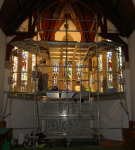 Scaffolding over altar
Scaffolding over altar
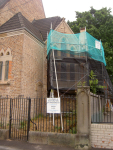 External scaffold around the apse
External scaffold around the apse
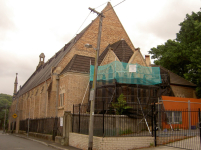 Rear of St James from the laneway
Rear of St James from the laneway
The job entailed firstly removing the wire guards to gain access to the windows and then completely removing all the old overglazing. This was in a terrible state, badly cracked and scoured and in fact should never have been installed in such a manner in the first place. When these windows were rebuilt some 40 or so years ago, the installers glazed a layer of protective glass hard up against the stained glass at the same time and in the same rebate. Consequently over the years huge deposits of debris had collected in the tiny space between the leaded glass and the overglazing, obscuring much of the beauty of the windows from the inside.
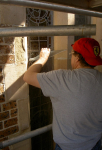 Removing overglazing
Removing overglazing
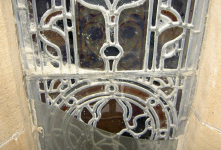 Trapped silt and overglazing
Trapped silt and overglazing
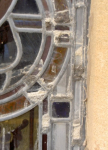 External build up of silt
External build up of silt
Assisting me on the job are Clive Hillier (seen above) and Chris Wellwoood. Chris used to run Aurora Stained Glass at Narellan for many years. He currently runs a Life Drawing class for Liverpool Art Society. Clive operates Clive Hillier Stained and Art Glass now located at Kingsford. He previously taught leadlighting for many years at Australian Stained Glass Supplies when they were at Leichhardt and then Camperdown, (now primarily online sales, with a warehouse at Arncliffe) so the windows are in very good hands. The three of us are taking great care with the windows, spending long hours painstakingly cleaning each pane of glass both inside and out. There are also many small repairs to be done and just one panel requiring reconstruction. The last task will be to re-cement all the windows firmly into their stone rebates and re-hang the wire guards.
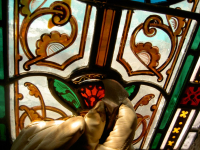 Scraping away sludge
Scraping away sludge
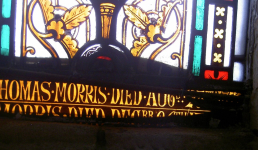 Obscured and damaged inscription panel
Obscured and damaged inscription panel
Restoration is a little like forensics or archeology and a good knowledge of many different studio practices is extremely useful in determining just what it is we are looking at. Painted stained glass windows tend to acquire an organic (I think) scum which builds up on the actual glass paint over the years. But in addition to this scum and accumulated cement render and house paint these windows were also covered in patches of black sludge.
In the making of a leadlight the final stage is to putty the gap between the glass and the lead with a glazing compound making them waterproof and binding the whole fabric together. Many studios use a slurry method to achieve this but effective clean-up is crucial with such a method and often this doesn't happen. Such was the case with the St James windows. When they were rebuilt sometime in the 1970's whoever applied the slurry left large clumps of the stuff adhered to the glass. A careful reading of the fired glass paint is required here to distinguish between sludge and the painted decoration hidden beneath. Fortunately the paint itself is quite strongly adhered to the glass (not always the case).
An advantage of having been rebuilt relatively recently (ie within maybe 20yrs or so) is that the lead fabric is quite sound so these windows should provide many more years of good service and the congregation will be able to appreciate their beauty anew once the scaffold comes down in a couple of weeks time.
Filed under: windows, window, stained glass, restoration, restorations, cleaning, cleanings | View Comments
The 2011 Blake Prize for Religious Art
15 Oct 2011
At a wedding reception many years ago I was asked what I do for a living, the usual wedding party conversation with strangers. My reply elicited a disparaging response: "So you're a religious artist?! That's old hat, religion is dead!"
One need only spend an hour wandering through the 2011 Blake Prize to realise how wrong that statement is and how relevant religious art can be to today's society. Such a diverse range of artistic expression, some of it somewhat obscure and impenetrable to be sure but most of the work extremely thought provoking.
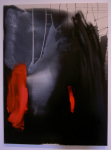 Linzie J Ellis
Linzie J Ellis
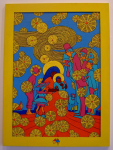 Martin Sharp
Martin Sharp
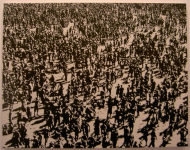 Ernest Aaron
Ernest Aaron
 Simon Blau
Simon Blau
In an exhibition such as the Blake I tend to feel that using Untitled for the title of a work is disappointing, particularly if there is no accompanying text in the room sheet; a title provides the viewer with at least a hint of the artist's intent, an access to the work. Nevertheless one of my favourite artworks in the show is "Untitled", an unapologetic abstract expressionist painting by Linzie Joanne Ellis. As an essay on the ineffable this works supremely well.
Equally successful for entirely different reasons is another "Untitled", the black and white painting of a large crowd under intense light by Ernest Aaron. As you approach this work the crowd disappears and the daubs of paint vibrate against each other. It is indeed a most successful metaphor for the transient nature of our existence, as the artist states in the catalogue.
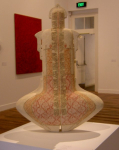 Anne Sheffer
Anne Sheffer
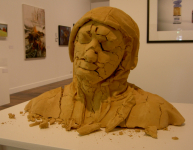 Tim Silver
Tim Silver
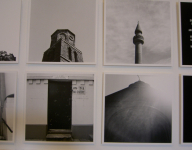 Zoe Aliu and Christos Tsiolkas
Zoe Aliu and Christos Tsiolkas
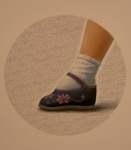 Fang Min Wu
Fang Min Wu
 Fang Min Wu
Fang Min Wu
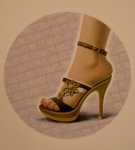 Fang Min Wu
Fang Min Wu
I was struck by the aesthetic integrity of Simon Blau's "The relocation of the horizotal on an instrument of torture": such a strong sculptural statement, conceptually profound yet profoundly simple. And who could not be moved by a crumbling portrait looking suspiciously like Mother Teresa made of wood filler by Tim Silver?
Embodying profound meaning within an object of beauty, Anne Sheffer's printed ceramic vessel has a quietly commanding presence. There were many pieces in this show that impressed me, too many to mention here. And some are clearly addressing the more open brief of social justice rather than religion per se. A very clever and engaging work in this field is "Not in her Mother's Footsteps, New China Doll" by Fang Min Wu. I think I laughed out loud when I saw this beautifully executed work.
Certainly Religion has a lot to answer for. Religious wars are seldom about religion at all and even when they are, how misguided is that very concept? In truth the phrase "Religious War' is an oxymoron. One of my favourite art jokes is Beware of the God a sticker you occasionally see for sale on sites like Amazon or Red Bubble.
Australian author and Nobel Prize winner Patrick White's comments are pertinent here. In a passage from The Solid Mandala his character Waldo, speaking of Religion and the Church, declaims that:
"Myths, evil enough in themselves, threatened one's sanity when further abstracted by incense and Latin, and became downright obscene if allowed to take shape in oleograph or plaster"
But Religion is by no means dead and nor is Religious Art, no matter what religion or lack of you or I may profess to. The 2011 Blake Prize closed today and begins its tour around the country shortly.
Filed under: sydney, religious art, national art school, 2011 | View Comments
Festival City
20 Sep 2011
I'm not sure when exactly it happened but Sydney has become a City of Creative Festivals, each one of them offering so much it's a wonder anyone has a chance to do the laundry or simply cook a meal! And if you're feeling bored or lonely you're just not paying attention.
As if the Sydney Film Festival in June was not enough, we now have the Sydney Underground Film Festival to open the month of September. Unfortunately yours truly has been beavering away in the studio and didn't get to any of the delightful films on offer.
UPDATE: Sadly this festival met its demise with COVID19.
Then Sydney Fringe Festival kicked off last week with a flurry of exhibitions and performances. I took myself over to St Peter's on Friday night to catch an outdoor bondage piece by my friend Garth Knight at the back of Tortuga Studios, just off May Street. I had no idea I would get caught up in a rambling visual feast of illuminated madness.
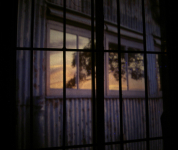 Projection on studio window
Projection on studio window
 The Man with the Cloudy Sky
The Man with the Cloudy Sky
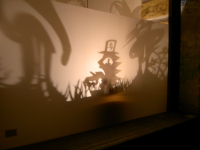 Shadow Projections
Shadow Projections
 Small drawing
Small drawing
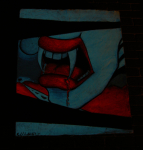 Fluorescent paint on canvas
Fluorescent paint on canvas
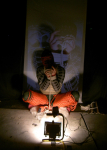 Self bondage workSelf bondage work
Self bondage workSelf bondage work
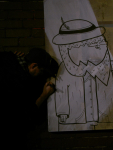 Live street art by Andros
Live street art by Andros
Following hard on the heels of the Sydney Fringe is Art and About. This is basically an outdoor art festival run by the City of Sydney which began largely as a way of decorating the city streets and parks for spring. It has evolved into a major Arts Festival with such immediacy, such relevance and artistic integrity, that it rivals the Sydney Biennale. As far as I am aware, this is the first year that international artists have been invited to participate, and what stars!
One such artist, Isidro Blasco has just had a solo show at Dominic Mersch Gallery (formerly at Dank Street Galleries, Waterloo). Blasco lives and works in New York and has wrought his transformational magic in one of our inner city laneways. I immediately fell in love with Isidro's work when I saw his 2010 exhibition at the Mersch Gallery. I wrote at the time that here is an artist who has brought photography into the realm of contemporary sculpture, adding nmuch to both disciplines.
Art and About will launch in Martin Place on Friday night, 23rd Sept. A walk through the photographic exhibition in Hyde Park is a must.
As Art and About winds up at the end of October (some of the laneway installations satay in place till end of Jan 2012), Paste Modernism 3 opens November 4th on Cockatoo Island in Sydney Harbour, as part of the street art festival called 'THE OUTPOST'.
The island will be transformed into a month long celebration of street and urban art, featuring prominent local and international artists as well as a number of events and projects similar to Paste-Modernism. The festival continues until Dec 11th.
Filed under: city of sydney, fringe festival, suff, art and about | View Comments
David Aspden
20 Aug 2011
On a whim on my way to the studio today I decided to first detour to the Dank Street Galleries. So glad I did! Not only was I priveleged to view an exhibition of drawings, maquettes and paintings by Joseph Albers at the Dominik Mersh Gallery but I discovered a retrospective of David Aspden's work upstairs at the Utopia Gallery. What a treat! Dank Street Galleries can be relied upon to provide a shot in the arm for any artlover but Aspden's Soft Forms is a truly inspiring exhibition.
The large and brightly coloured "Grevillea" is a symphony of reds and orange. Contrasted with the dark and brooding "Transendent Night" and several other works in sombre, moody colour schemes, the whole exhibition sings. The lyrical "May Day" is very John Olsen-like in its playful splashes and daubs of strongly-coloured paint applied over a wash of greens. And the majestic "Zahir", the largest work in the collection, is absolutley impressive in its confident handling of shape and colour. A tour-de-force in the lexicon of Australian abstraction.
The Art Gallery of NSW is currently hosting a retrospective of Aspden's work entitled The Colour of Music and Place, which I've yet to see, but I can hardly wait to get there and I would strongly recommend this show to anyone needing a visual boost, an injection of aesthetic energy. Particularly as the Utopia Gallery exhibition finshes today!
On the International art front, Canadian glass artist Sarah Hall has sent me a link to her latest commission, a collaborative mosaic entitled Wondrous Love - Opus 3881, which incorporates a new pipe organ in the sanctuary of St Barnabas on the Desert, Paradise Valley, Arizona. It is indeed rather wondrous and the slide show gives a fascinating insight into the making process.
Filed under: art gallery of nsw, australian painter, david aspden, utopia gallery | View Comments
A New Window for Merewether Anglican
14 Aug 2011
I'm still a bit exhausted but that's probably as much to do with the cold I have as with the installation at Merewether, which I didn't finish until about 8.30pm Thursday 11th. Merewerther is a beachside suburb of Newcastle, about 2hrs drive north of Sydney. So even getting up at 6am to be at the studio by 7 and on the road by about 8.15 still meant I was cementing the rebate in the dark- and that was without much of a lunch break.
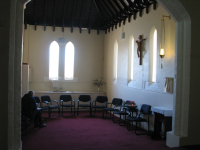 The Prayer Space
The Prayer Space
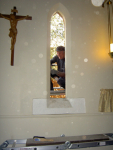 Chris excavating the window
Chris excavating the window
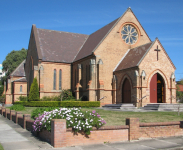 St Augustine's Merewether
St Augustine's Merewether
I was very grateful to Chris Welwood for his assistance on the job; chopping glass out of cement render is nobody's idea of fun and this one was as hard as they come. Whoever installed the spotswood when the Prayer Room extension was added to St Augustine's Church did not understand the concept of making a soft, sandy mortar that is easily excavated in later years.
Chris used to run his own business, Aurora Stained Glass in Narellan, near Campbelltown, for quite some years. He produced a lot of fine work together with his partner Julie but found eventually that the business was unsustainable. It was great to have someone on hand who knew how to handle leadlights, even though he had not done a masonry installation before.
I was very grateful to David of Our Town Glass and Glazing in nearby Dudley for his consultation on fitting the overglazing. He was able to point out a few deficiencies in my planned approach. When I get back onsite during the coming week we'll be able to provide effective and discreet protective glazing for the windows.
UPDATE 2013:
three of the five windows are now installed into the Prayer Space at St Augustine's; Our Town Glass & Glazing has closed, and David has retired.
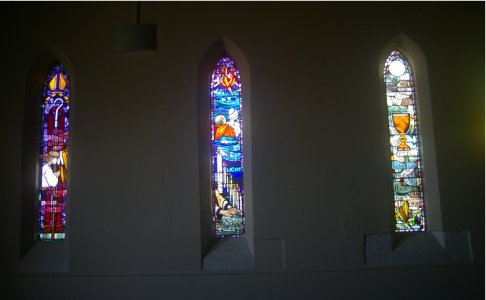 Three new windows at Merwether Anglican Church
Three new windows at Merwether Anglican Church
Filed under: ecclesiastic stained glass, the eucharist, merewether anglican church | View Comments
Breaking News
29 Jul 2011
I'm pretty excited to have one of my windows on the cover of Stained Glass Quarterly Magazine, published by the Stained Glass Association of America. The window, to which I gave the Latin name Majestas Domini, is based on an image of Christ in Majesty, a woven altar frontal from an early Twelfth Century church in Barcelona.
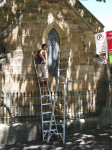 Pre-existing leadlight
Pre-existing leadlight
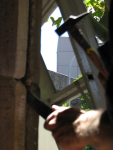 Hacking out the rebate
Hacking out the rebate
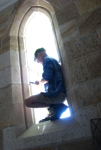 The window opening
The window opening
 New stained glass installed
New stained glass installed
The photos above show some of the installation process, chopping out the old diamond leadlight and installing the new glass. The chap on the far left is Mateo, a traveller from Italy. He ran his own glass art business in the Canary Islands, specialising in copperfoil, before arriving in Australia. Mateo started working for Sallie Portnoy on a large commission and later came across to assist me in the studio for a couple of months.
![]() Full-size charcoal cartoon
Full-size charcoal cartoon
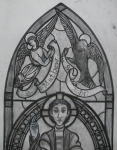 Detail of charcoal cartoon
Detail of charcoal cartoon
 Detail of charcoal cartoon
Detail of charcoal cartoon
 Earlier version of cartoon
Earlier version of cartoon
 Early version of the Hand
Early version of the Hand
As I mention in the Stained Glass Quarterly article, there was much revision of the charcoal cartoon, going back many times to my source material. In fact the whole design process took about ten months before a solution was reached which was satisfactory to both me and the Parish Priest, Fr Colin Fowler. The Hand of Christ in particular had me stumped (the original Romanesque version was found to be too open) until one night I had a breakthrough and photographed my own hand in an attitude of blessing.
Filed under: jeffrey hamilton, stained glass quarterly magazine summer 2011, st bede's catholic church, pyrmont | View Comments
Speaking at the Art Gallery of NSW
18 Jul 2011
I was chuffed to have been invited to speak at the Art Gallery of NSW on Sat July 9th as a part of their new exhibition Poetry of Drawing: Pre-Raphaelite designs, studies and watercolours, thanks to the recommendation of my colleague Ray Barlow.
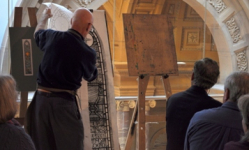 Explaining cartoons and cutlines
Explaining cartoons and cutlines
 Drawing a cartoon for glass
Drawing a cartoon for glass
The exhibition includes quite a number of sketches and cartoons for stained glass windows and also an actual stained glass panel and the associated full-size drawings. The window is the very first of Edward Burne-Jones' prodigious output: it has none of the finesse and complexity of Burne-Jones' later works but is nevertheless a valuable addition to what is a beautiful exhibition and to my knowledge is the first stained glass window exhibited by the State Gallery.
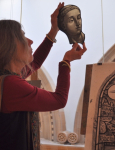 Examining work by S. Moor
Examining work by S. Moor
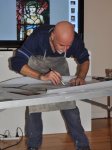 Cutting glass
Cutting glass
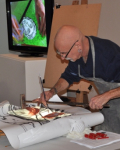 Using the cartoon to trace
Using the cartoon to trace
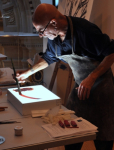 Painting on glass
Painting on glass
Positioned at the entrance to the exhibition I had an attentive audience of around 30, growing to about 50or so by the end of the hour. After a general discussion of the work of Edward Burne- Jones and his colleagues, where I mentioned the beautiful windows of All Saints Anglican Church at Hunters Hill, I took the audience through the making of a stained glass window from inception of design to painting the glass. It was a lot of information to pass on in just one hour but it seemed as though they enjoyed the presentation.
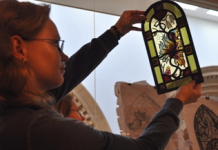 An example of enamelled glass
An example of enamelled glass
 Explaining a point
Explaining a point
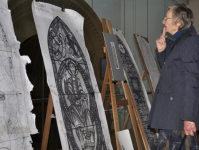 Taking it all in
Taking it all in
The exhibition continues until 4th September, with more demonstrations and lectures each Saturday, organised by Josephine Touma, Acting Snr Coordinator of Public Programs for the Gallery. Josephine was a great help in setting everything up. It was terrific having a large screen data projector to show the video files I had of the making of the St Bede's window at Pyrmont in 2009. And much thanks to my friend Robert Knapman, intrepid photographer, who took on the assignment of capturing me in action.
Filed under: demonstration, processes of making stained glass, art gallery of nsw, pre-raphaelite drawing, demonstrations | View Comments
End of an Era
29 Jun 2011
Today, 29th June 2011 marks the sad demise of both Finn's Art Glass and The Glass Connection, two of Sydney's major players in the stained glass industry. Long time competitors, the two firms joined in partnership only a few years ago in an effort to rationalise overheads and boost profits. Together they relocated to Milperra, moving into the factory once occupied by Richardson's Glass on Milperra Road.
Prior to that Finn's were located in Boundary Rd, Peakhurst for many years, their previous factory in Penshurst St having been destroyed by fire. Finn's was a leading force in the retail sector and a major educator. All fields of the glass crafts were addressed with the exception of hot glass as they did not have a furnace. But many experts, both local and international, ran workshops in beadmaking, fusing and kiln forming, glass painting, powder and frit work, leadlight and copper foil and also mosaic.
The Stained Glass Shoppe was established in 1962 by Neil Finn who at one stage had been apprenticed to Bolton Glass, the leadlighting firm who fabricated all of Stephen Moor's work. Finn's Stained Glass remained a family company for many years, with his three daughters and both sons working in the company at various times. Paddy Robinson (who had also worked for Moor for several years) had a long association with Finn's Glass as their chief designer for stained glass commissions. Neil and Paddy formed Finglinna Studios together in 1989.
In 1985 Neil also established Bent Glass Products as a separate company in Boundary Road. Neil was always experimenting and developing techniques and aquired considerable skill in the area of bending and forming glass . He was in fact the 'official' restorer for Tiffany bent panel lampshades. The business grew at a surprising rate, eventually changing its name to Bent and Curved Glass and moving to new premises in Milperra Rd, Revesby.
The Glass Connection was established in the 1980s as a strictly wholesale glass merchant to the stained glass industry and had several moves before settling in at Peakhurst not far from Finns Glass. Origianlly a partnership, Ray Grigg became sole owner and was a tireless voice within the larger glass and glazing industry for a fair go for stained glass practitioners.
It was The Glass Connection's 'go-to' girl Renee Pimental who after a period of parenting re-entered the industry and, together with Ray, purchased Finns Art Glass, injecting a new energy into the company. Renee expanded on Finn's role as an educator, bringing into Australia many artists prominent in their fields and expanding the skills base of her staff. At its peak Finns Art Glass was managing 200 students per week.
Filed under: closure of finns art glass, glass connection | View Comments
Wayne Pearson's Post-Graduate Exhibition
23 Jun 2011
After 3 years of sustained effort, experimentation, trial and error (but mostly success) Wayne Pearson has produced an astounding collection of portraits of some of the leading figures in the Australian studio glass scene. A group of almost 40 collectors, curators, practitioners and gallerists now grace the walls of one of the main exhibition spaces at Sydney College of the Arts Rozelle campus.
 Dr Gerry King
Dr Gerry King
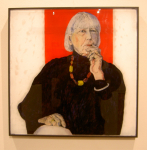 Judi Elliott
Judi Elliott
 yours truly
yours truly
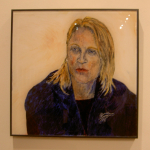 Suzanne, Kirra Gallery
Suzanne, Kirra Gallery
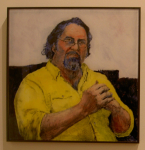 Michael Sclerrone of Wagga Gallery
Michael Sclerrone of Wagga Gallery
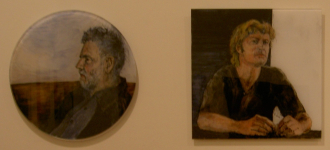 Stephen Skillitzi, Charles Butcher
Stephen Skillitzi, Charles Butcher
Wayne first interviewed all of his subjects and during the interview Marina his wife took photographs for reference. Wayne says that the interviews were an integral part of the whole process and very much governed the form of the final portrait. It was a fascinating process to be a part of. As well as these narrative works, his doctorate also explored the non-subjective, amorphous nature of glass where the material itself carries meaning, or rather allows the viewer to fall into the work and create his own narrative .
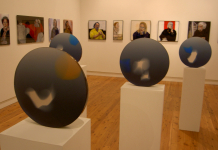 Sculptural forms
Sculptural forms
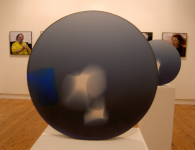 Sculptural form
Sculptural form
The surface of these pieces was particular seductive and was only finally resolved in the past few months with the help of Bridgett Thomas, a fellow student. Each form was ground with a wet pumice paste and scouring cloth to achieve a beautiful satin finish. Light is captured within the form and the veiwer finds himself dwelling there, lost for long moments.
Filed under: reverse glass painting, portraiture, australian glass artists, wayne pearson exhibition, sydney college of arts | View Comments
Successful Installation
16 Jun 2011
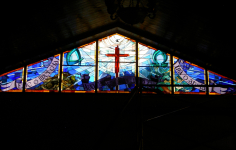 The Resurrection fully installed
The Resurrection fully installed
With the assistance of two friends I installed this window in the Samoan Christian Church on Forest Rd Lugarno over four days, finishing Sat 12th June. It's been my major project over the previous 6months.
The design is a re-working of a set of triple lancet windows I made in 1999 for All Saints Anglican Church in Tumut.
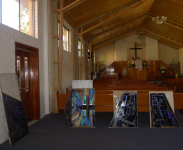 Arriving at the Church
Arriving at the Church
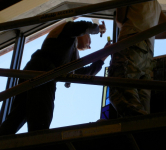 Up the Scaffold
Up the Scaffold
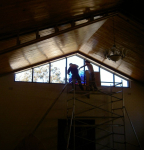 Making a Start
Making a Start
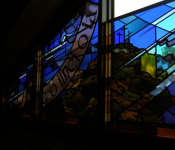 Detail of left hand side
Detail of left hand side
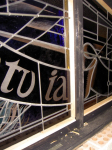 Detail of fixing method
Detail of fixing method
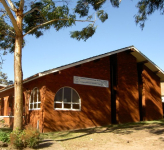 The Samoan Christian Church
The Samoan Christian Church
Filed under: new stained glass window, samoan christian church, lugarno, nsw australia | View Comments
Subscribe
The Latest Happenings in my World
This blog is where you will find my latest news. It can range from posting images of progress of the current commission to art crit to political or social commentary, both national and international. Anything, basically, that's commanding my attention and I feel is worth sharing with you, my reader. Enjoy. My previous blog can be found at jeffreyhamilton.blogspot.com
